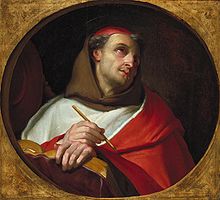
Back Bonaventura AF بونافنتورا Arabic بونافنتورا ARZ Bonaventura de Fidanza AST Bonaventura BAR Банавентура BE Банавэнтура BE-X-OLD Бонавентура Bulgarian Bonaventura de Bagnoregio Catalan Svatý Bonaventura Czech
Bonaventure | |||||||||||||||||
|---|---|---|---|---|---|---|---|---|---|---|---|---|---|---|---|---|---|
 17th-century portrait of Bonaventure by French painter and friar Claude François | |||||||||||||||||
| Friar Cardinal Bishop of Albano Doctor of the Church Seraphic Doctor Teacher of the Faith | |||||||||||||||||
| Born | Giovanni di Fidanza 1221 Civita di Bagnoregio, Latium, Papal States | ||||||||||||||||
| Died | 15 July 1274 (aged 52–53) Lyon, Lyonnais, Kingdom of Burgundy-Arles | ||||||||||||||||
| Venerated in | Catholic Church Church of England | ||||||||||||||||
| Canonized | 14 April 1482, Rome by Pope Sixtus IV | ||||||||||||||||
| Feast | 15 July, Some are celebrated every 14th of July | ||||||||||||||||
| Attributes | Cardinal's hat on a bush; ciborium; Holy Communion; cardinal in Franciscan robes, usually reading or writing | ||||||||||||||||
Philosophy career | |||||||||||||||||
| Other names | Doctor Seraphicus ("Seraphic Doctor") | ||||||||||||||||
| Alma mater | University of Paris | ||||||||||||||||
| Era | Medieval philosophy | ||||||||||||||||
| Region | Western philosophy | ||||||||||||||||
| School | Scholasticism Augustinianism Neoplatonism[1][2] Philosophical realism Medieval realism (moderate realism) | ||||||||||||||||
| Institutions | University of Paris | ||||||||||||||||
Main interests | Metaphysics | ||||||||||||||||
Notable ideas | Bonaventure's version of Anselm of Canterbury's ontological argument Exemplarism Illuminationism | ||||||||||||||||
| Ecclesiastical career | |||||||||||||||||
| Religion | Catholicism | ||||||||||||||||
| Church | Roman Catholic Church | ||||||||||||||||
Offices held | Cardinal-Bishop of Albano | ||||||||||||||||
Ordination history | |||||||||||||||||
| |||||||||||||||||
| Source(s):[5] | |||||||||||||||||
|
Preview warning: Page using Template:Infobox philosopher with unknown parameter "influences" Preview warning: Page using Template:Infobox philosopher with unknown parameter "influenced" | |||||||||||||||||
| Part of a series on |
| Scholasticism |
|---|
 |
Bonaventure OFM (/ˈbɒnəvɛntʃər, ˌbɒnəˈvɛntʃər/ BON-ə-ven-chər, -VEN-; Italian: Bonaventura da Bagnoregio [ˌbɔnavenˈtuːra da (b)baɲɲoˈrɛːdʒo]; Latin: Bonaventura de Balneoregio; born Giovanni di Fidanza; 1221 – 15 July 1274[6]) was an Italian Catholic Franciscan bishop, cardinal, scholastic theologian and philosopher.
The seventh Minister General of the Order of Friars Minor, he also served for a time as Bishop of Albano. He was canonised on 14 April 1482 by Pope Sixtus IV and declared a Doctor of the Church in 1588 by Pope Sixtus V, becoming known as the "Seraphic Doctor" (Latin: Doctor Seraphicus). His feast day is 15 July.
Many writings from the Middle Ages once attributed to him have been subsequently re-classified under the name "Pseudo-Bonaventure".
- ^ "Bonaventure on the Neoplatonic Hierarchy of Virtues - Medieval Philosophy". Wilmington For Christ. 17 December 2020.
- ^ "Bonaventure (c.1217–74) - Routledge Encyclopedia of Philosophy". www.rep.routledge.com.
- ^ "Anselm of Canterbury (1033–1109)", Internet Encyclopedia of Philosophy, 2006, retrieved 10 November 2017
- ^ "Bonaventure - On the Necessity of Being - Introduction". bartholomew.stanford.edu.
- ^ "St. Bonaventura (Giovanni) Cardinal [Catholic-Hierarchy]".
- ^ M. Walsh, ed. (1991). Butler's Lives of the Saints. New York: HarperCollins. p. 216. ISBN 9780060692995.